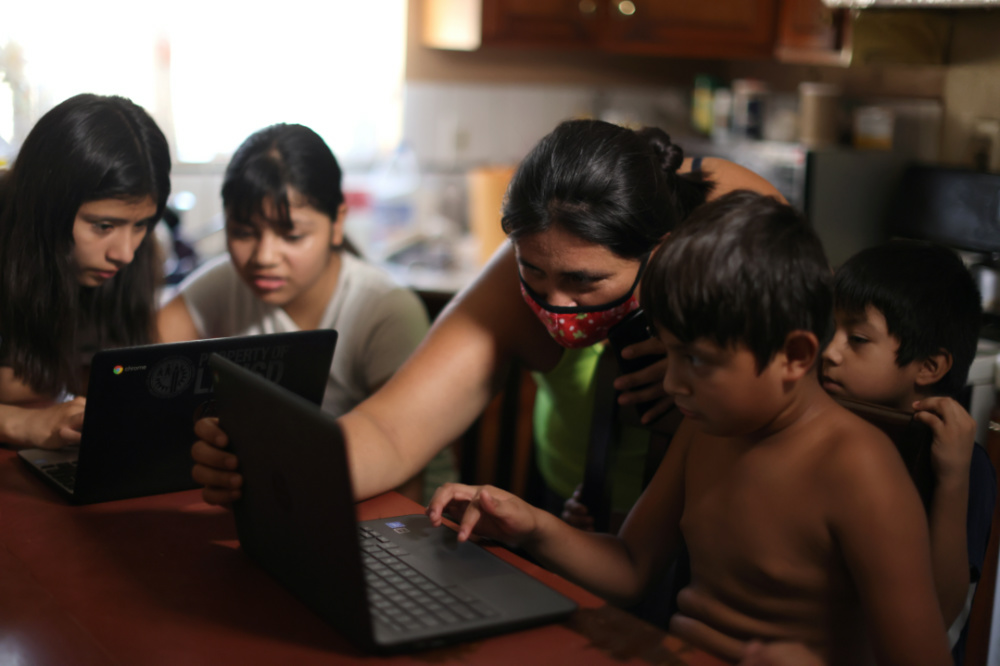New York City, US
Thomson Reuters Foundation
Office life will be different after COVID-19, with desks far apart, Plexiglass barriers and a health warning on handshakes. But the biggest change could be a notable absence of women.
Once the pandemic eases sufficiently for workers to return to their desks and factory floors, women are more likely to continue working from home because they shoulder the bulk of domestic responsibilities, experts said.

Los Angeles Unified School District students Keiley Flores, 13, Andrea Ramos, 10, and Alexander Ramos, eight, work on school-issued computers with unreliable internet connectivity, as their mother Anely Solis, 32, and their brother Enrique Ramos, five, look on, during the global outbreak of the coronavirus disease (COVID-19), at their home in Los Angeles, California, US, on 18th August. PICTURE: Reuters/Lucy Nicholson/File photo.
“There is a danger there that women are the ones who are likely to opt to work from home, and offices may just end up being the places where men go to,” said Phumzile Mlambo-Ngcuka, executive director of UN Women.
Mothers have been three times more likely than fathers to be responsible for most housework and childcare during COVID-19, according to a recent survey by LeanIn.Org, a women’s rights group, and McKinsey & Company, a global consultancy.
Many workplaces closed when coronavirus lockdowns took hold around the world in March, leading millions of employees to work remotely from home. For many it remains unclear when it will be safe to return, and many may well opt to keep working from home.
If parents are given a choice of returning to workplaces or staying home, the imbalance in unpaid domestic labor may convince a disproportional number of women to choose remote work, said Mlambo-Ngcuka, who is also the United Nations Under-Secretary-General.
“We worked so hard to say a woman’s place is not in the kitchen. We don’t want corona to say a woman’s place is in the home, that she’s sitting in the kitchen with her laptop, and the men’s place is in the office,” she said in a recent interview with the Thomson Reuters Foundation.
Worldwide, women do more than 75 per cent of the unpaid work at home on average, according to the International Labour Organization, which said in a 2018 report that such work was the major obstacle to women’s participation and progress in the workforce.
It found that 606 million women of working age said they were not in the workforce due to unpaid care responsibilities, compared with 41 million men.
“Undo progress”
A sudden decline in the number of women in the workplace could roll back decades of gains, advocates say.
“If it does go that road, it’s going to undo so much progress that we’ve made,” said Christian Nunes, president of rights group the National Organization for Women, adding that she thought most women would want to return to workplaces.
“We’re still fighting so hard for women’s place in the workplace that women are going to fight to hold onto those places,” she said. “We’re used to working and parenting and having to balance multiple roles.”
Mlambo-Ngcuka said the unequal pull of home-working will require employers to redouble their efforts to keep workplaces diverse and inclusive.
“Employers need to be aware of that and take measures to make sure they don’t have the unintended consequences of making the workplace a place where guys get together,” she said.
But Lorraine Hariton, chief executive of Catalyst, a group that advocates for women in business, said multiple factors – not just household duties – would play into families’ decisions on who returns to the workplace.
“The scenarios about where we will be and what that new world is going to look like is speculative,” she said.
“There are a lot of variables here.”





